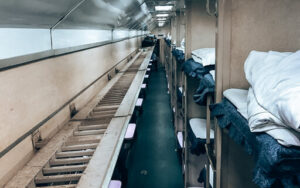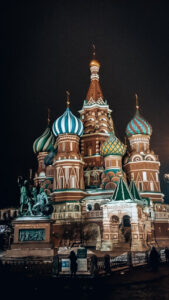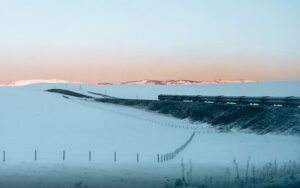Guest Blogger Amy van Loon from Home Made Adventures wrote a guest blog for us about the Trans-Mongolian Railway.
Recognize this? You’re planning your next trip and you want to go on a trip far away from home. Especially after last year… Also, you want this trip to be as sustainable as possible. While planning your trip, you are aware that going by plane isn’t as sustainable. So now what?
The amazing spots along the Trans-Mongolian Railway
Cancel your plans for that trip and just stay within a few hundred kilometers from home? Definitely not! As mentioned in the Green Stamps blog you have learned you can travel by train. Let me first give you a few examples of my experiences, before diving into the amazing spots along the Trans-Mongolian Railway. When I was living in China I never traveled by plane. Instead, I traveled by train all the time. Sometimes I took the high-speed train and within 6 hours I traveled 1.200 kilometers between Shanghai and Beijing. That’s incredible right?! The next time I traveled the low-budget and slow travel way by overnight train. The same ride between Shanghai and Beijing would take me about 13 hours. To be honest, traveling by the slow overnight train is for me the best way to travel. I can relax instead of rushing around all the time. And I know for sure it gives you as well the time to enjoy the different landscapes a country has to offer, and you will meet a lot of local people along the way. After all these experiences it was clear to me that my next trip had to be by train as well. A whole lot better for the environment and a whole lot more fun than traveling by plane!

So, what better trip to choose, but the trans-Mongolia railway! A trip by train that’s about 8.000 km between Moscow and Beijing. The Trans-Mongolian Railway you can take into both directions. If you decide to stay the entire trip on the train, you will spend 6 full days and nights on this one single train. But this can take longer when you visit the right spots during the Trans-Mongolian Railway experience. During the Trans-Mongolian Railway, you will be crossing the border from Europe to Asia, and it takes you through many different landscapes. In this article, I take you through all the different landscapes and I will share my favorite places to get off the train so you will have the ultimate Trans-Mongolian Railway experience. As mentioned, you can travel the Trans-Mongolian Railway in both directions. I started my trip in Moscow, but you can also travel from Beijing to Moscow.
Let’s dive into the most amazing spots along the Trans-Mongolian Railway! Moscow is a bustling city and it’s the heart of Russia, culture, history, and traditions. Moscow has it all. Make sure you don’t just travel to Moscow to get on the Trans-Mongolian Railway and take a few days to explore this diverse city.

The moment is there, it’s departure time on the Trans-Mongolian Railway! Your adventure on the Trans-Mongolian Railway is about to start. The first part of the trip will probably be the longest stretch of your time on this journey. There is a big chance that you will be spending 2 or 3 days straight on the Trans-Mongolian Railway before you reach your next destination. Many kilometers and hours of staring outside the window will fly by. I promise. During this first stretch on the Trans-Mongolian Railway, you will still be in the European part of Russia. You will mainly see big birch forests, small villages, and hilly landscapes.
Through the Ural Mountains, the Trans-Mongolian Railway will take you towards Yekaterinburg, which is the geographical border between Europe and Asia. Around Yekaterinburg, you will start seeing the Russian part of the Taiga forest. Taiga is a vast, cold, and moist coniferous forest that is the largest in the world. It also belongs to the lungs of the earth. The Taiga includes major parts of Canada, Scandinavia, Russia, and Mongolia. Yekaterinburg can be your first stop, but from what I’ve heard this city isn’t too special. Though I haven’t been there so I can’t confirm this. I believe it’s better to stay about two more days on the train and get off at Krasnoyarsk. In Krasnoyarsk, you can make amazing hikes in the Russian Taiga forest at Stolby National Park.

Next up with the Trans-Mongolian Railway, you will head towards Irkutsk. During this stretch, you will mainly see the Taiga when looking out of your window. Irkutsk isn’t a special city, but it’s nice to just wander around the center during the afternoon. You can use Irkutsk as a starting point for a trip to Lake Baikal. Lake Baikal is the largest freshwater lake in the world, and it has about 20% of all drinking water on the planet. While taking the Trans-Mongolian Railway this is definitely one of the spots to visit. The lake has rare biodiversity, but it is under threat. Fortunately, more and more eco-activists are mobilizing to protect the fragile ecosystem.
As I said, you can use Irkutsk as a starting point to travel to Lake Baikal. For example, you can go to Lystvjanka, which is a small town with an amazing view over the lake. In the winter it’s the perfect place to go for winter sport, which will be pretty quiet, and you will have the entire village for yourself. During summertime, it will be packed with Russian tourists who come here to relax at the lake. No matter when you get to Irkutsk, either during winter or summer when going on the Trans-Mongolian Railway make sure you walk a part of the Great Baikal Trail. While hiking this trail, there is a beautiful part that takes you from Lystvjanka towards Bolshie Koty. This is a 25-kilometer-long hike. Good to know: when you go on the Trans-Mongolian Railway during summertime, you can take a boat back to Lystvjanka. In wintertime, you can only get back on foot.

Next on the journey on the Trans-Mongolian Railway, you continue your trip over the steppe of Mongolia toward the capital of the country, Ulaanbaatar. The biggest part of the Mongolian citizens has a sustainable lifestyle. In Ulaanbaatar though, this is quite different. Especially during the wintertime, the pollution increases a lot. There are two simple reasons for this pollution. About half of the Mongolian citizens live in the capital. With temperatures around minus 30 degrees Celsius all winter long, it takes a lot of energy to get the Mongolian houses to a comfortable temperature. Fortunately, they are becoming more aware of this pollution problem and are taking more and more steps towards a healthier living environment. For example, you can see more and more hybrid cars in Ulaanbaatar than ever before!
My advice would be to stay at least 2 weeks in Mongolia while on the Trans-Mongolian Railway journey because this country has so much to offer. The people are extremely friendly and you’re always more than welcome into their homes. Compared to the pollution in the capital city, the nomads living on the steppe and in the desert live very sustainably. One of the reasons for this is that they don’t have a lot of possessions. This is because they’re moving a couple of times per year. It is very impressive to see how they reuse everything they have. As an example, I played some games with the bones of a goat. Bones of the same goat they have used for their milk, meat, and skin. Right next to every yurt you will find one single solar panel to provide power for a light, the black and white TV, and their mobile phone. These nomads are mainly living self-sufficient. You can find vegetable gardens all around their houses. Seeing their way of living is truly one of the amazing spots during the Trans-Mongolian Railway!
The last part of the Trans-Mongolian Railway takes you through the Gobi Desert. In the summer temperatures can rise easily up to 40 degrees. In wintertime temperatures can drop as low as minus 30 degrees Celsius. Even in these extreme conditions, you will find Mongolian people living in their yurt. Incredible, right?
At the Mongolian Chinese border, you will have another interesting experience! Another unique experience during the Trans-Mongolian Railway. This time it has nothing to do with nature, but with the train itself. Because the trails in Mongolia and the trails in China aren’t the same, they will lift the train and change the wheels of the train while you’re in it.

After crossing the border your last few hours on the Trans-Mongolian Railway have officially started. You will end the Trans-Mongolian Railway in one of the most polluted cities, Beijing. The city has a lot to offer, so take your time to explore the amazing places.
To answer the question at the beginning of the article, can you travel far away from home without flying? Yes, you can! The Trans-Mongolian Railway is just one of the examples of a long train journey, and there are so many to choose from. And If you can’t find one, you can also plan an amazing train adventure yourself! Traveling by train is an experience itself, but it’s also a sustainable way of traveling. When we look at the numbers it appears you emit an average of 4 times less CO2 than the same trip by plane. That’s massive! Yes, going by plane is faster, but the train is an adventure and an experience on its own. If you want to make it completely durable and sustainable, you have to travel back home by train as well. Of course, it’s understandable if that doesn’t work out all the time. Only flying one-way means you’re thinking about nature. For more questions about the Trans-Mongolian Railway make sure to leave a comment!

Written by: Amy van Loon


